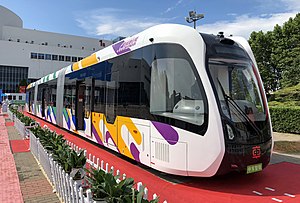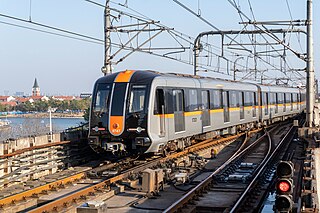
The Shanghai Metro (Chinese: 上海地铁; pinyin: Shànghǎi Dìtiě; Shanghainese: Zaon6he5 Di6thiq7) is a rapid transit system in Shanghai, operating urban and suburban transit services to 14 of its 16 municipal districts and to the neighboring township of Huaqiao, in Kunshan, Jiangsu Province.

Guided buses are buses capable of being steered by external means, usually on a dedicated track or roll way that excludes other traffic, permitting the maintenance of schedules even during rush hours. Unlike railbus, trolleybuses or rubber-tyred trams, for part of their routes guided buses are able to share road space with general traffic along conventional roads, or with conventional buses on standard bus lanes.

Wuhan Metro is a rapid transit system serving the city of Wuhan, Hubei, China. Owned and operated by Wuhan Metro Group Co., Ltd., the network now includes 12 lines, 300 stations, and 486.3 km (302.2 mi) of route length. With 1.22 billion annual passengers in 2019, Wuhan Metro is the sixth-busiest rapid transit system in mainland China. There are a number of lines or sections under construction. The government of Wuhan City promised the citizens that at least two lines or sections open every year.

Translohr is a rubber-tyred tramway system, originally developed by Lohr Industrie of France and now run by a consortium of Alstom Transport and Fonds stratégique d'investissement (FSI) as newTL, which took over from Lohr in 2012. It is used in Paris and Clermont-Ferrand, France; Medellín, Colombia; and Venice-Mestre and Padua in Italy. In June 2012, Alstom Group and the Strategic Investment Fund acquired Translohr for €35 million.

The Chengdu Metro is the rapid transit system of Chengdu, the capital of Sichuan, China. With the opening of Line 1 on 27 September 2010, the system consists of 13 subway lines and 1 light rail line. It has subsequently undergone rapid expansion. Since the opening of Lines 6, 8, 9, and 17 on 18 December 2020, the Chengdu Metro is the 4th longest metro system in the world.

Urban rail transit in China encompasses a broad range of urban and suburban electric passenger rail mass transit systems including subway, light rail, tram and maglev. Some classifications also include non-rail bus rapid transport. As of 31 December 2023, China has the world's longest urban rail transit system with more than 10,000 km (6,200 mi) of urban rail nationwide in 49 systems in 47 cities, accounting for 9 of the 10 longest metro systems, with the exceptions of the Moscow Metro or metro systems in Seoul combined if metro systems in the same cities are merged in the rank.

A rubber-tyred tram is a development of the guided bus in which a vehicle is guided by a fixed rail in the road surface and draws current from overhead electric wires.

Zhengzhou Metro is a rapid transit rail network serving urban and suburban districts of Zhengzhou, the capital city of Henan province. It is operated by the state owned Zhengzhou Metro Group. As of December 2023, the network has 11 operational lines, with a network length of 344 km (213.8 mi) and 217 stations. Opened on 28 December 2013, it is the first metro system in Henan province, and 18th in mainland China.
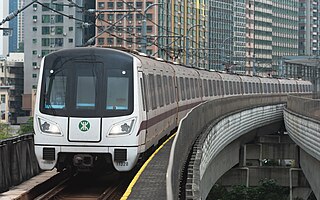
Shenzhen Metro Line 11 opened on 28 June 2016. Line 11 has a length of 53.5 km (33.2 mi) and a total of 19 stations. It connects the CBDs of Futian, Nanshan and Qianhai to Shenzhen Bao'an International Airport and onward to Fuyong, Shajing and Songgang suburban areas. It serves as both a regional express line from the west coast of Shenzhen to the city core area and an airport rail link. Compared with the other lines of Shenzhen Metro, Line 11 has a longer spacing between stops for a higher speed service. Trains of Line 11 were designed to run at 120 km/h (75 mph), up to 50% faster than other lines, but currently limited to 80 km/h (50 mph) in some sections for infrastructure, tunnel wind pressure, track geometry issues and noise reasons. Construction of Line 11 started in April 2012 and test running begun at the end of March 2016. Trains run at a 4-minute frequency between Futian and Airport North, 8-minute frequency for full length trains during morning rush hours, 5-minute interval for full length during evening rush hours, and 6-minute interval for non-peak hours. Currently it takes slightly more than half an hour to travel from Futian to the Airport. Line 11's color is violet.

Line 5 is a southwest–northeast line of Suzhou Rail Transit. It opened on June 29, 2021. The line is 44.1 kilometers long. Its south-western terminus is at Taihu Xiangshan station in Wuzhong District, with its north-eastern terminus at Yangchenghu South station in Suzhou Industrial Park.
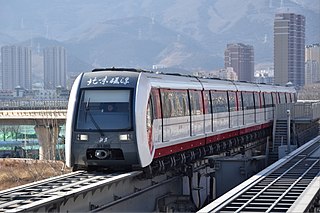
Line S1 of the Beijing Subway is a medium-low speed maglev line. It is operated by the Beijing Mass Transit Railway Operation Corporation Limited. The line was opened on 30 December 2017. It starts from Pingguoyuan in Shijingshan District and goes west towards Shichang in Mentougou District.

Several cities in China had tram systems during the 20th century; however, by the end of the century, only Dalian and Changchun remained extant. However the 21st century has seen a resurgence in tram transport systems as China attempts to combat with urban traffic congestion and pollution.

Shenzhen Tram is a light rail system consisting of two tram routes in Longhua District, Shenzhen, Guangdong, China. Construction commenced on 27 December 2013 and public testing started on 30 June 2017, with the system fully opening on 28 October 2017. The tram system integrates the north side of Longhua into the city's rail network and is expected to significantly ease commuting difficulties.
Trams in Wuhan may refer to any one of the tram systems currently operational in the city of Wuhan, Hubei, China. The first tram started revenue service in Wuhan is the Auto-city T1 Line, which began on July 28, 2017. Subsequently, Optics Valley tram started revenue service from April 1, 2018.
Tianshui Tram is a light rail system consisting of one route in Qinzhou District and Maiji District, Tianshui, Gansu, China.
Liuzhou Rail Transit is a monorail metro system currently under construction in Liuzhou, Guangxi Zhuang autonomous region, China. Currently, Lines 1 and 2 are under construction using monorails manufactured under a JV between Bombardier Transportation and CRRC. It is planned to consist of lines 1, 2, 3 and 4 and suburban lines S1, S2 and S3.

Chengdu Tram Line 2 is a tram line in Chengdu, China. The line has a total length of 39.3 kilometres (24.4 mi) and 35 stations. It has a 'Y' layout and runs from the Chengdu West railway station to Pixian West railway station and Hongguang. The line was officially started in December 2015, and the 13.7 km (8.5 mi) demonstration section of the line was opened on 26 December 2018, and the remaining sections were opened on 27 December 2019.
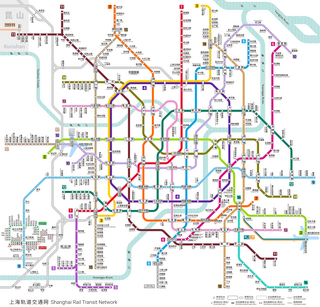
Shanghai Rail Transit includes all rail transit lines operating in Shanghai, mainly composed of High-volume railway system, Low-to-medium-volume railway system and Maglev system. The system was established on May 28, 1993, when Shanghai Metro Line 1 opened.

Wenshan Tram is a tram system serving Qiubei County, Wenshan Prefecture, Yunnan, China.

The Lingang Medium Transport Volume, also known as Lingang Digital-rail Rapid Transit, is a rapid transit system operating within Lingang in Pudong District, Shanghai, China. It started operations on 30 June 2021, and is operated by the Shanghai Lingang Public Transport Company. The system operates as an Autonomous Rail Rapid Transit (ART) system, but conventional bus rapid transit-specification buses currently run on the system too.
